Complete Guide to Washing Carpet Rugs Effectively
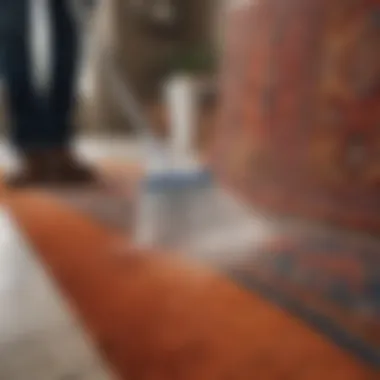
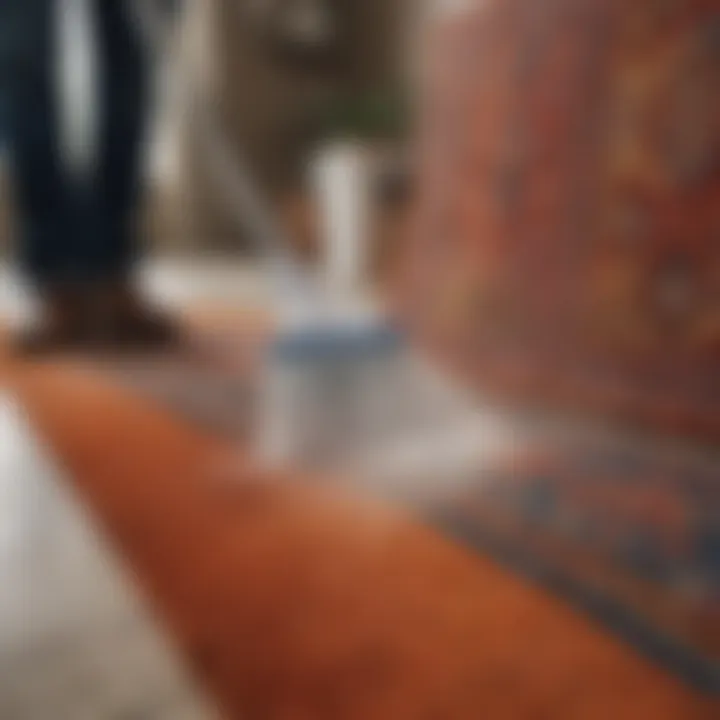
Intro
Washing carpet rugs is often seen as a mundane task, yet it requires a level of knowledge and finesse that can truly make a difference in the longevity and appearance of your textiles. There’s more to it than just tossing a rug into a washing machine or scrubbing it haphazardly with some soap and water. This guide aims to unpack the myriad of details involved in caring for your carpet rugs, ensuring they not only look fabulous but also stand the test of time.
Throughout the article, we will address several crucial points: the different types of carpet materials, techniques suited to each kind, cleaning products that are effective and safe, and mistakes you ought to avoid while cleaning. Emphasis will also be placed on preventive measures and regular maintenance, which are vital for sustaining the vibrancy of your rugs.
Cleaning a carpet rug is not merely about aesthetics; it’s about preserving a staple of home decor that can significantly affect the atmosphere of your space. A fresh, clean rug can adapt the tone of a room while also creating a welcome environment for guests. With these factors in mind, let’s delve deeper.
Understanding Carpet Rugs
When it comes to accentuating a room’s character, carpet rugs play a pivotal role. They not only serve a functional purpose—softening our steps and adding warmth—but they also bring forth a myriad of styles, colors, and textures that can complement or even transform an entire space. Understanding the essence of carpet rugs is fundamental, particularly for those who wish to maintain their integrity and beauty. Selecting the right rug, knowing how to care for it, and being aware of different types and materials can save homeowners from headaches later down the line.
Types of Carpet Rugs
Carpet rugs come in an impressive variety that caters to different tastes, needs, and budgets. Let’s break it down further:
Oriental Rugs
Oriental rugs are often viewed as treasures, woven with rich history and intricate designs. They are typically hand-knotted and boast vibrant colors derived from natural dyes, making each piece unique. Their craftsmanship can make them somewhat expensive, yet they are a beneficial choice for those seeking timeless elegance. A key characteristic of Oriental rugs is their durability; with proper care, they can last for generations. However, they do require specialized cleaning methods to maintain their vibrant appearance, which may be a disadvantage if not kept in mind.
Machine-Made Rugs
Machine-made rugs, often more affordable, are known for their consistency in design and manufacturing. They can mimic the appearance of Oriental rugs but are generally less expensive and easier to maintain. The key advantage is their wide availability, making it easier to find the right design for your space. However, their durability may not match that of handwoven pieces, leading to a shorter lifespan. Homeowners considering these rugs should think about their cleaning needs and how often they might need replacements.
Natural Fiber Rugs
Natural fiber rugs, crafted from materials like jute, sisal, or seagrass, bring an earthy charm to interiors. They are often chosen for their eco-friendliness and unique textures, which can create a warm, inviting atmosphere. One of the unique features of natural fiber rugs is their ability to handle heavy foot traffic without showing too much wear. However, they can be more susceptible to stains and moisture damage, meaning that regular care and cleaning are crucial.
Materials and Weaves
The material and weave of a carpet rug significantly influence its comfort, appearance, and maintenance needs. Different weaves result in varied textures:
Wool
Wool is a traditional choice for many carpet rugs, offering a luxurious feel and excellent durability. Its natural resilience makes it a solid option for high-traffic areas. The key aspect of wool is its ability to regulate temperature and absorb moisture, enhancing indoor comfort. Nevertheless, wool requires specific cleaning solutions to avoid damage, which can add complexity to maintenance.
Synthetic Fibers
Synthetic fibers, such as nylon or polyester, present a cost-effective alternative, especially for families with children or pets. They are often stain-resistant and easy to clean, which is why many choose them for a busy household. While synthetic rugs may lack the richness of natural fibers, they stand up to wear and tear quite well. Their downside can be that they don’t breathe as well as natural fibers, making them less comfortable underfoot in warmer climates.
Cotton and Blends
Cotton rugs offer a soft touch and are often available at a reasonable price. They are washable, making them a popular choice for casual spaces or areas like kitchens. The key benefit of cotton and blends is their versatility; they come in various colors and patterns. However, they might not wear as well in high-traffic areas compared to wool or synthetic rugs. Regular cleaning and care are essential to maintain their appearance.
"Understanding the types, materials, and care of carpet rugs can dramatically alter their lifespan and appearance, keeping them vibrant for years!"
Why Regular Cleaning is Essential
Keeping carpet rugs in good shape goes beyond just appearance. Regular cleaning can significantly enhance the overall health of your home, making it not only visually appealing but also a healthier living environment. This section delves into the reasons why regular cleaning should not be neglected, focusing on two core components: preventing allergens and extending the carpet's lifespan.
Preventing Allergens
One of the weighty reasons for maintaining a cleaning regime for carpet rugs is the battle against allergens. Numerous particles such as dust mite droppings, pet dander, and pollen can settle deeply into the fibers of rugs. These aren't just nuisances; they can provoke allergies or respiratory issues in sensitive individuals.
Consider this: a well-cleaned rug can drastically reduce the chances of these allergens lingering in your home. Regular vacuuming reduces buildup of dirt and dust while professional cleaning can offer a more thorough cleanse that penetrates mats deeply, picking up allergens that have been hidden out of sight.
Residents with pets or those living in urban areas tend to face higher allergen concentrations. Routine washing becomes critical for them.
Some practical steps to mitigate allergens are:
- Frequent vacuuming at least once a week. Use a vacuum equipped with a HEPA filter to trap smaller particles.
- Professional cleaning every 6 to 12 months. This helps in expelling allergens embedded in the rugs' fibers.
- Using protective covers during allergy season. These covers can greatly minimize dust exposure.
"Regular cleaning is like a shield, preventing allergens from turning your home into a sneeze factory."
Extending Carpet Lifespan
Routine cleaning is also linked to longevity. Carpet rugs endure foot traffic, spills, and stains. Over time, without proper cleaning, these factors can lead to fraying and fading. Regular maintenance helps in protecting these textiles, keeping them looking good and prolonging their usage.
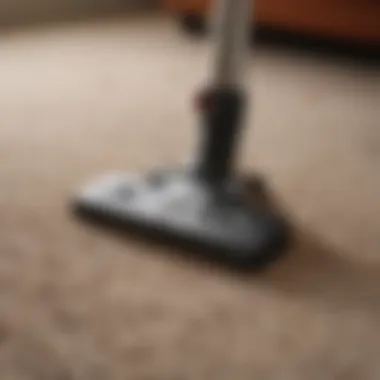
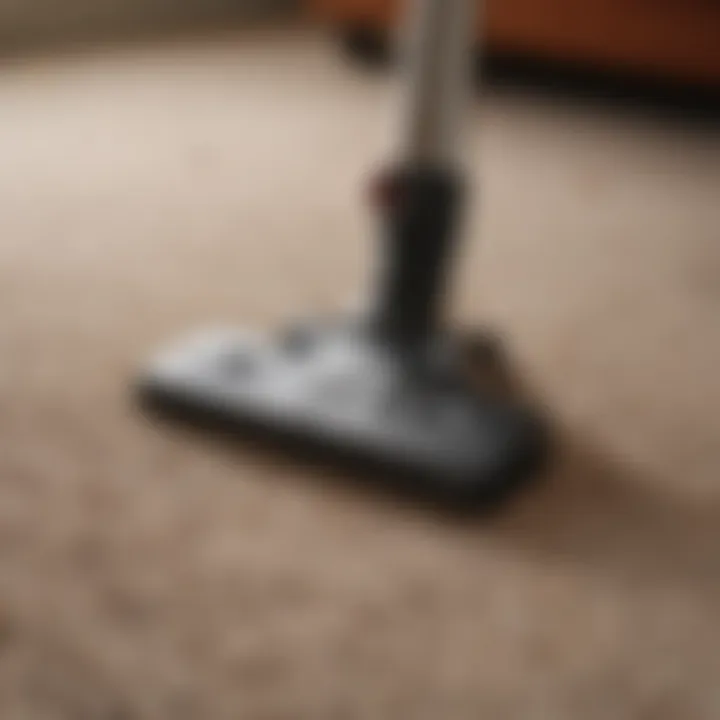
When you invest in a quality carpet, it makes sense to extend its life through proper care. Just like you would maintain a car to ensure it runs well for years, regular cleaning is akin to giving your rugs the attention they deserve.
Consider these points for maximizing the lifespan of your carpets:
- Immediate attention to spills. Blot the area instead of rubbing it, which could spread the stain.
- Periodic deep cleaning to eliminate dirt that can degrade fibers.
- Rotating rugs seasonally so that wear and tear is evenly distributed.
- Avoiding sunlight exposure to prevent fading, by placing rugs in shaded areas or using curtains.
Tools Required for Washing Carpet Rugs
When it comes to washing carpet rugs, having the right tools can make all the difference. Each item plays a specific role in ensuring that your rugs not only come out clean but stay in good shape for years to come. Missing the mark on the right instrument might lead to damage, ineffective cleaning, or quite frankly, extra hassle that simply isn’t necessary. This section will cover essential tools like vacuum cleaners, brushes, scrubbers, and cleaning solutions, each bringing its own benefits to the cleaning process.
Vacuum Cleaners
A vacuum cleaner is the unsung hero of carpet maintenance. Before diving into any washing process, it’s crucial to remove dirt and debris that have settled within the fibers of your rug. Regular vacuuming prevents dirt accumulation that undermines the integrity of the fabric over time. Moreover, there are various types of vacuum cleaners designed to suit different rug types; for example, a canister vacuum might be better suited for a heavy wool rug, while a stick vacuum works wonders on lighter materials.
Remember, effective vacuuming can reduce the need for more intensive cleaning processes later on, saving time and effort!
Brushes and Scrubbers
Brushing is not just for aesthetics, it’s a fundamental step in cleaning washables. Brushes and scrubbers help lift dirt from the fibers. Selecting the right bristle type is crucial; you wouldn’t want anything too harsh that could ruin the texture or color of your rugs. A soft-bristle brush is generally safe for most types, while firmer brushes can be utilized on more durable materials. Additionally, having a hand-held scrubber ready can help reach stubborn areas or any messes that don’t want to budge.
Cleaning Solutions
The choice of cleaning solution can greatly impact the quality of the cleaning job. It's vital to select a cleaner that's suitable for your specific rug material to avoid any potential damage.
Homemade Solutions
Homemade cleaning solutions can often be a good alternative to commercial options. Many people appreciate that these solutions usually consist of ingredients found right in the kitchen, like vinegar, baking soda, or dish soap. One popular blend is white vinegar mixed with water, renowned for its deodorizing and stain-lifting powers. The key characteristic of homemade solutions is their ability to be tailored to your specific needs, making them an attractive choice for those mindful of chemical exposure.
However, the downside is that consistency can vary. What works wonders today might not yield the same results tomorrow. Some stubborn stains may require specialized products that are often found in commercial offerings instead.
Commercial Cleaners
On the flip side, commercial cleaners present a reliable option for those looking to tackle tough stains or for specialized cleaning needs. These products often come with specific formulations depending on the type of stain—be it pet-related messes or food spills. Their key characteristic is generally their high effectiveness, as they are crafted specifically to target certain types of dirt and discoloration. Plus, they come with usage instructions that guide users to get the best results.
Yet, they do have some disadvantages, including the possibility of harsh chemicals that could irritate sensitive individuals or pets. Some brands also carry a hefty price tag, so it’s important to weigh the benefits against the costs before purchase.
When deciding between homemade and commercial solutions, consider your specific rug needs and the types of stains you’re up against. Having a mix of both options might just cover all bases—creating a comprehensive strategy for maintaining the beauty of your rugs.
Preparation for Cleaning Process
Understanding how to prepare for the cleaning of carpet rugs is a fundamental yet often overlooked phase that can make or break the entire cleaning process. This preparatory stage helps ensure everything runs smoothly and contributes significantly to the effectiveness of whatever cleaning method you choose down the line. By giving proper attention to preparation, you not only enhance the potential for a thorough clean but also extend the lifespan of your carpet rugs.
Assessing the Rug Condition
Before you jump headlong into washing, it’s pivotal to assess the condition of the rug. This means looking for any specific damages—such as frayed edges, discoloration, or thinning areas—that could be exacerbated with improper cleaning techniques. Take note of stains; some are merely surface-level, while others may have penetrated deeper fibers.
A good practice is to check both sides of the rug. You might discover some hidden spots or dirt build-up that will require extra attention. Additionally, look at the rug's backing. A rug in decent shape should have a sturdy backing and no evident signs of wear. Conduct a gentle pull on the fibers; if they feel loose or come out, it may signal that more delicate methods should be employed.
Choosing the Right Method
Once you've assessed your rug’s condition, the next step is selecting an appropriate cleaning method. Each approach has its merits and is suited to different fabric types, levels of soiling, and any other factors that might influence cleaning success.
Hand Washing
Hand washing stands out due to its personal touch and control over the cleaning process. It allows you to directly manipulate the rug and pay meticulous attention to problem spots. This method is particularly beneficial for delicate rugs that may risk damage in harsher cleaning scenarios.
However, the labor-intensive nature of hand washing can be a drawback; it demands both time and physical effort. If you’re facing a significantly soiled rug, the elbow grease required can be considerable. Still, for intrinsic values like artistic craftsmanship and care, hand washing showcases the art of keeping your rugs in pristine condition.
Machine Washing
Machine washing has become a modern lifeline for those with busy schedules. The particular feature of this method is its efficiency. Running your rug through a washing machine can drastically reduce your effort and time. But—there’s always a but—this method isn’t without its downsides. It’s vital to ensure your rug is machine-approved; otherwise, you risk shrinking or damaging the fibers.
Moreover, while machine washing cleans effectively, it may miss hidden pockets of dirt or not offer the same deep clean as hand washing. So, it’s essential to evaluate whether your rug can withstand a spin cycle or if it requires gentler handling.
Dry Cleaning
Dry cleaning can be a godsend for rugs made of sensitive fibers that necessitate specialized treatments, such as silk or some wool varieties. This method uses chemical solvents to clean the rug without introducing water, which could lead to shrinkage or warping. The key characteristic of dry cleaning lies in its proficiency at breaking down grease and oils that water often struggles with — making it an effective method for certain stains.
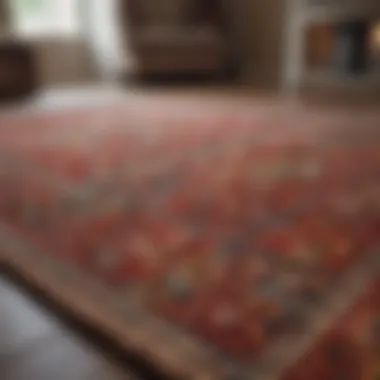
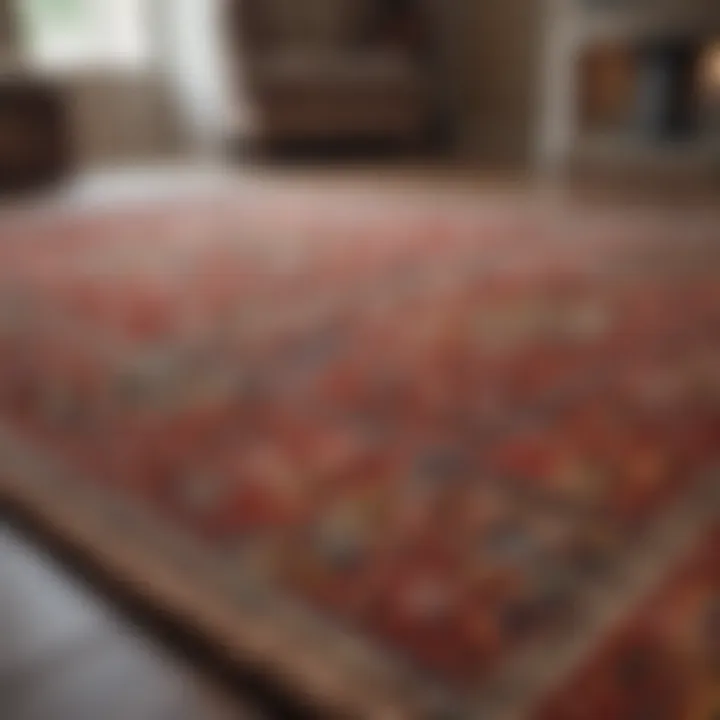
However, the trade-off is added costs. Dry cleaning also may not be as widely available as other methods, so you might need to seek professional help. If your rug is a valuable family heirloom, the investment in dry cleaning could very well be worth it due to the specialized care it receives.
In summary: Each cleaning method offers distinct advantages and disadvantages. Evaluating the rug’s condition and choosing the right cleaning approach ensures a successful rejuvenation of your carpet rugs while maintaining their integrity.
Prepare wisely, and the result will reflect your care!
Step-by-Step Washing Techniques
Washing carpet rugs isn't just about tossing them in water and waiting for the best. The key to maintaining their beauty and structure lies in a step-by-step approach. Every method you use plays a crucial role in preserving the fibrous integrity and aesthetic appeal of your rugs. If you skip a step or rush the process, you might end up doing more harm than good. This section will provide a detailed exploration of each technique, helping you understand the importance of getting it right.
Vacuum First
Before tackling stains or grabbing your brushes, the first step should always be to vacuum the rug thoroughly. Regular vacuuming gets rid of dirt, dust, and allergens that settle deep into the fibers. Think of it like prepping the canvas before you begin painting; you wouldn’t start without cleaning up first, right?
Using the right vacuum is essential, too. For example, a vacuum with a beater bar is often effective on plush rugs but might be too harsh on delicate fibers. Make sure you adjust the settings accordingly, especially since this small detail can mean the difference between a clean rug and one that’s permanently damaged.
Pre-Treat Stains
Stains are the bane of any rug owner, so addressing them before the deep cleaning process is vital. Stains can set in quickly, and if you don’t act fast, they may become a permanent part of the fabric.
Try using a gentle stain remover suitable for your rug type. Apply it in a small, inconspicuous area first to check for colorfastness. A simple solution, like a mix of vinegar and water, can often work wonders. Remember, blot don’t rub; working a stain can lead to further damage to the rug’s fibers.
Scrubbing and Washing
Once the stains are pre-treated, it’s time for the main event: scrubbing and washing. When washing, opt for a soft brush or cloth that will clean without being overwhelming. Excessive scrubbing can cause fibers to fray. Ideally, you should scrub in the direction of the pile to avoid any fraying or shedding. If using a machine, be cautious and follow the rug’s care label for guidance on water temperature and cycle settings.
Rinsing Process
Rinsing is just as crucial as washing. It removes any leftover soap or cleaning solution that could cause residue build-up and attract dirt over time. Rinse with cold water thoroughly, ensuring that no soap remains. This process can also be done with a carpet cleaner designed for such tasks. Remember: after rinsing, it’s good practice to keep an eye on the rug to avoid any unintended stretching or distortion while it’s wet.
Drying Techniques
Air Drying
Air drying, while simple, is often the best option. After rinsing your rug, lay it flat in a well-ventilated space, ideally outside in the shade to prevent colors from fading. Air drying doesn’t just save you from the risk of heat damage; it also helps in preventing mold growth, which can be a serious issue in moist conditions. This gentle method allows the fibers to return to their natural shape without distortion.
Key characteristics of air drying include:
- Gentleness: No harsh elements are applied.
- Effectiveness: Reduces the risk of odor and mildew.
While the method can take longer, it's often well worth it compared to the alternatives.
Using a Fan
If you’re in need of a quicker drying solution, using a fan can be a game changer. Position a fan to direct airflow across the wet rug. This not only speeds up the drying process but also circulates air to prevent mustiness that sometimes comes with damp rugs.
Key benefits of using a fan include:
- Speed: Cuts down drying time significantly.
- Help with odor prevention: Keeps air flowing and fresh.
Use caution, however. Ensure the fan doesn’t blow directly onto the rug if it’s delicate or if you’re concerned about any fraying that could occur.
Post-Cleaning Care
Once you've put in the hard work of washing your carpet rug, you're not quite done yet. The post-cleaning stage is a crucial moment that can make or break the results you achieved through your washing efforts. This phase encompasses all the steps you take after the actual cleaning process to ensure your rug maintains its beauty and durability.
Caring for your carpet after washing helps preserve its fibers, keep odors at bay, and prevent dirt from accumulating quickly again. A little bit of attention here goes a long way. Let’s delve deeper into how you keep that freshly cleaned rug looking top-notch, starting with regular maintenance tips.
Regular Maintenance Tips
Keeping up with maintenance should be a vital part of your routine, much like changing the oil in your car. Here are some valuable tips to help keep your rug in excellent shape:
- Routine Vacuuming: It’s often said that an ounce of prevention is worth a pound of cure. Vacuum regularly to catch dirt that gets worked deep into the fibers before it has a chance to settle.
- Spot Cleaning: Life happens, and spills are likely to occur. Addressing stains as soon as they happen is key. Use a light tap with a clean cloth to absorb the excess, then apply a suitable cleaning solution.
- Use a Rug Pad: It may seem trivial, but a quality rug pad can protect your carpet from excessive wear and tear. It keeps the rug anchored in place, which minimizes movement that can lead to fraying.
- Rotate Your Rug: Just like the sun moves across the sky, so does sunlight indoors. Rotate your rug every few months for even exposure to light. This helps prevent fading in one area more than another and prolongs its life.
Adopting these practices ensures your carpet retains its luster and structural integrity at the same time.
Dealing with Odors
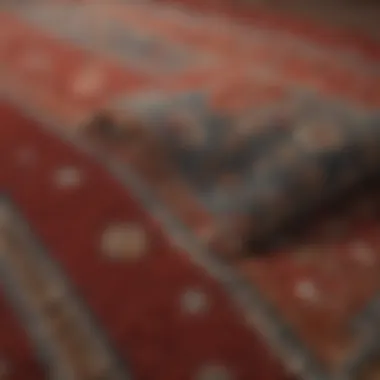
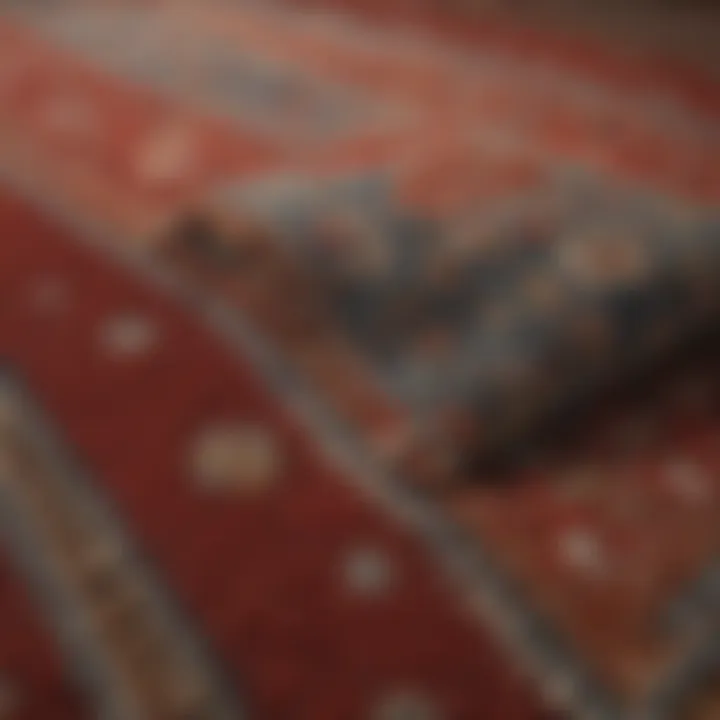
Even after a thorough wash, odors can linger—particularly in rugs made from natural fibers like wool. Here are a few methods to keep your carpet smelling fresh:
- Baking Soda Magic: Sprinkle baking soda liberally over your rug and let it sit for a few hours or overnight. This humble powder works wonders by absorbing unwanted smells.
- Vinegar Solution: Mix equal parts of white vinegar and water in a spray bottle and lightly mist the rug. Do not overdo it; a little goes a long way. The vinegar smell dissipates quickly, taking any unwanted odors with it.
- Ventilation: Don’t underestimate the power of fresh air. After a cleaning, take your rug outside on a dry, breezy day. Letting it air out not only helps remove dampness but aids in clearing out any stale odors, too.
- Essential Oils: For those who prefer fragrances, dropped essential oils on cotton balls can work. Place these in inconspicuous spots under the rug. Be mindful that it shouldn’t be too much, as you don’t want it to overpower the room.
Remember, odors in carpet rugs can develop from multiple sources – moisture, pets, or just plain neglect. Proactively tackling this issue means you can enjoy your carpet to the fullest without that lingering doubt of smell.
In summary, paying attention to post-cleaning care will ensure your carpet rugs remain a source of pride in your home rather than a point of concern. By adopting the right maintenance habits and effectively dealing with odors, you can extend the life of your rugs and enhance their beauty for years to come.
Common Mistakes to Avoid
When it comes to cleaning carpet rugs, the process can seem pretty straightforward. However, many individuals inadvertently trip over basic mistakes that can lead to unintentional damage. Avoiding these common pitfalls can significantly affect the effectiveness of your rug cleaning routine. Here are three main mistakes to watch out for, each with its own set of consequences.
Ignoring Care Labels
Every carpet rug comes with care instructions, often nestled among the fibers or attached as a tag. Disregarding these labels is like tossing a map in the trash when exploring uncharted territory. Each rug type has specific requirements that dictate how it should be cleaned. Ignoring these care labels can result in unforeseen damage.
For instance, some rugs may require dry cleaning only, while others can withstand a good scrubbing. Using hot water on a wool rug could lead to shrinkage, and applying a heavy-duty detergent on a delicate silk carpet can strip away its sheen.
To make the most of your carpet cleaning efforts, always read and follow the care instructions that come with your rug. If the information is unclear, consult professionals or reliable sources online, like Wikipedia or Department of Interior Design.
Using Wrong Cleaning Products
Not all cleaning products are created equal. It's vital to choose suitable solutions for your specific carpet rug material. Using a harsh chemical cleaner on a delicate fiber can be as disastrous as using a bulldozer to plant tulips.
Synthetic fibers might handle stronger chemicals, but natural fibers like cotton or wool require gentler treatment. Always opt for pH-balanced cleaning agents that won't break down fibers. Also, test any new product on a small, hidden area of the rug to preempt any adverse reactions.
Here’s a quick list of dos and don'ts:
- Do use a gentle cleaner for wool and silk.
- Don't use bleach or other aggressive chemicals on any rug.
- Do water down concentrates before application.
- Don’t forget to check product compatibility!
Over-Wetting the Rug
In the excitement to clean, it can be tempting to thoroughly saturate the rug in water and cleaning solution. However, over-wetting can lead to more harm than good. Saturated rugs can take forever to dry, promoting the growth of mold and mildew. This not only affects the rug's appearance but could lead to health concerns due to spores in the environment.
Instead, approach the washing methodically. Opt for a slightly damp cleaning technique rather than soaking the mess. Follow these guidelines to prevent over-wetting:
- Use a spray bottle for more control over moisture.
- Test the rug's absorbency initially.
- Ensure the rug is lifted during washing to prevent grime from settling.
- Avoid a waterlogged mess at all costs.
"An ounce of prevention is worth a pound of cure," they say. In the case of carpet rug cleaning, this couldn’t be truer. A little knowledge goes a long way in preserving the beauty and longevity of your treasured rugs.
When to Seek Professional Help
At times, the prospect of cleaning a carpet rug may seem daunting. While many can handle the occasional vacuum and spot treatment, certain situations call for a more specialized approach. Knowing when to enlist the expertise of professional cleaners can save headaches down the road, maintain the rug's aesthetic, and even preserve its value. This section highlights essential elements to consider when determining if it's time to reach out to the experts.
Identifying Difficult Stains
Some stains have a reputation for being stubborn, whether it’s coffee spills from an early morning rush or red wine accidents during a dinner party. These marks can often seem insurmountable. If a stain has set in despite your best efforts or has multiple layers of residue, a professional might be the best bet. Professionals have access to specialized tools and solutions that can penetrate deep into the fibers, lifting stains without causing damage. Additionally, methods like steam cleaning can tackle deeper soiling that may not be visible on the surface.
Especially with natural fibers, such as wool or silk, pushing too hard with conventional cleaning products might result in fading or distortion of the fabric's texture. Recognizing these signs can prevent further damage, ensuring your prized carpet remains in top shape.
"The longer a stain lingers, the more challenging it becomes to remove, making early intervention crucial."
Understanding Rug Value
Rugs can carry significant monetary and sentimental value, be it an heirloom from a grandparent or a carefully selected piece acquired while traveling abroad. Knowing the worth of your rug is integral when considering cleaning options.
If the rug is valuable—be it due to age, rarity, or craftsmanship—it’s wise to consult professionals who specialize in rug cleaning rather than attempting a DIY route. Professional cleaners can provide assessments and techniques that honor the integrity of the fibers and weaves while addressing stubborn dirt and stains. Proper care can greatly increase its lifespan and value.
Moreover, issues relating to repairs, such as fraying edges or unraveling seams, are also best addressed by experienced hands. Taking these rugs to someone who possesses both the knowledge and skills can provide peace of mind and ensure your investment is protected into the future.
Closure
As we wrap up this detailed exploration of washing carpet rugs, it's clear that grappling with this topic requires both understanding and appreciation. The act of cleaning these decor treasures involves not just the techniques but also an understanding of their value and the right care methods. Regular rug maintenance enhances not only the aesthetic but prolongs the life of the fibers, ultimately saving money and resources in the long run.
Recap of Key Points
- Types of Rugs: Understanding the different types of carpet rugs—Oriental, machine-made, and natural fiber—allows for a tailored approach in cleaning methods. Each type has its own cleaning quirks and preferred care protocols.
- Proper Tools and Products: Using the right vacuum cleaner, brushes, and cleaning solutions is essential. Whether it’s a homemade solution or a well-reviewed commercial cleaner, selecting proper products can make a significant difference.
- Methods of Washing: Depending on the rug's condition and type, methods like hand washing, machine washing, or dry cleaning are crucial to ensure effective cleaning without damage. Always assess both before and after cleaning.
- Post-Cleaning Maintenance: Keeping in mind maintenance tips and dealing with odors ensures your rugs stay fresh and vibrant long after they’ve been cleaned.
- Professional Help: Recognizing when to call in the pros—especially for tough stains or valuable rugs—is key to preserving the artistry and worth of your carpet.
Final Thoughts on Cleaning
Caring for carpet rugs is not merely a chore—it's a craft. Each cleaning session is an opportunity to extend their life and maintain their beauty. The journey to clean rugs should be seen not just as routine but as an essential aspect of maintaining your home’s overall ambiance. Through proper care, we celebrate the history that each rug embodies and confer respect to the craftsmanship behind their creation. Care for your rugs is a reflection of your style and values, indicating a commitment to quality that resonates beyond aesthetics to embody a deeper appreciation for art in our living spaces.
"Every thread woven tells a tale; cleaning is the art of preserving stories."
In the end, as you get into the rhythm of washing carpet rugs, remember that patience and attention to detail will yield the best results. Every rug has its idiosyncrasies, so adapting your methods as per those unique traits will ultimately lead to a rewarding outcome.







